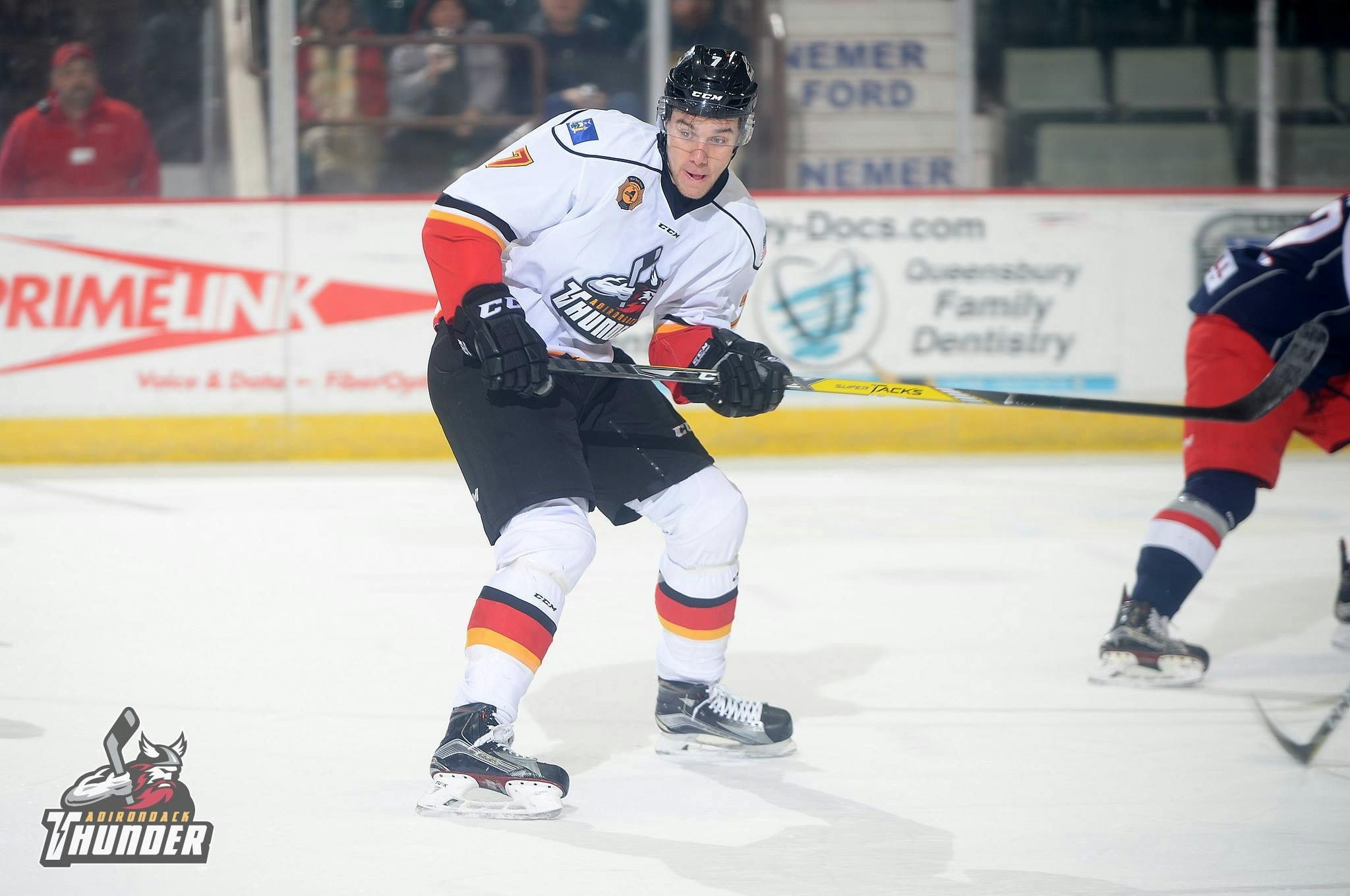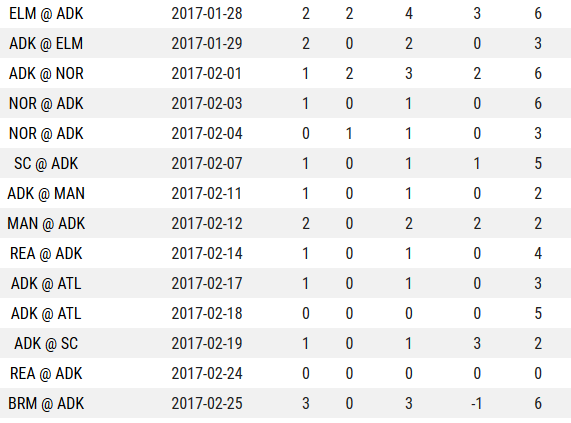It literally does not matter that Stepan Falkovsky left

In an otherwise dull day yesterday, the big news (measured by social media/pageviews/comment section reaction) was 2016 seventh round pick Stepan Falkovsky.
In a day when the Flames’ biggest move was a depth NHL signing, somehow the biggest piece of news was someone else’s signing (Brad Treliving looked surprised that it was even brought up – Ryan agrees with this assessment).
It also induced a bit of rage, which seems very dramatic for such an unimportant piece of business. If we really need to have this conversation, here’s why it literally does not matter that the Flames did not even make a bona fide offer to Falkovsky.
He is probably never going to score 20 goals ever again
Much, perhaps 100%, is made of Falkovsky scoring 21 goals in the ECHL. A defenceman scoring 20 goals anywhere is a rarity, and if it’s in a pro league, then it’s even better. That’s kind of the reason for the uproar against this move: how could anyone let a 20 goal scoring defenceman go, much less a rookie in a pro league who just hit his second decade of existence?
Let’s look deeper. Sixteen of those 21 goals came during a 14-game stretch. Here’s what that looked like (from the ECHL website):

The first column is goals, but let’s look at that last column. That’s for shots on goal.
If you add it all together, he scored 16 goals on 53 shots, or 30.19 SH% (he finished the season at 16.94 SH%). That screams unsustainable. If you look at the rest of his season, when he scored five goals on 71 shots, you get 7.04 SH%.
That number feels more true of Falkovsky because his SH% in the OHL last season was 7.96%. Using that number, his goal total drops to 10, which is a much less significant number.
The true story of Falkovsky’s 20 goals is that he got extremely hot for 14 games. In the 30 games previous, he only had four goals on 47 shots (8.51 SH%). In the 10 games following, he had one goal on 24 shots (4.17 SH%). Falkovsky averaged 3.79 shots per game during the streak and 1.78 anytime else. Sometimes, you’re just feeling it.
It was an aberration. An exciting aberration, but an aberration nonetheless. I think we can all agree that he’s unlikely to ever score 20 again, but he still isn’t an offensive guru by any means. Even if we adjust his SH% to career levels, he’s a single digit goal guy. Even more concerning, only seven of those goals came at 5v5. Unless he’s on the powerplay (in the goal-friendly ECHL), he’s not scoring much.
Like we recently learned, shooting percentage is a thing that is always and often subject to random variance and doing business based off of that number is almost always going to end in heartache.
But what of his future?
But 21 goals is 21 goals. Doesn’t matter how he scored them. Given his young age (started the season 19 years old, turned 20 in December), what he did is probably very unique.
And that is true. Since the 2004-05 lockout, only four ECHL defenders who turned 20 before the end of the year have had similar seasons (within 10% of Falkovsky’s 0.59 PPG).
Similar feels like a stretch though. The four are Dominic D’Amour, Mackenzie Weegar, Jesse Graham, and Ben Chiarot. Of those four, Chiarot spent the most time in the ECHL, playing 24 games. It’s a bit wonky to claim players were comparable when all they had to do was have a cup of coffee in the ECHL for a few weeks.
The reason that these guys spent so little time there is because they split time between the ECHL and the AHL, which seems to indicate their quality relative to their ECHL peers. Falkovsky never got that. To be fair, Stockton was bursting at the seams with defenders, but Keegan Kanzig and Ryan Culkin got shots in the AHL before Falkovsky did.
Back to those four players. The only one who has found success in the NHL is Chiarot, who is the definition of a 6/7 defenceman. The only other guy to come close is Weegar, who had a brief cameo appearance with the Panthers this year, and is still very much on the fringes of the NHL. If he makes it, he’s likely to be a 6/7.
That seems to be an appropriate ceiling for Falkovsky. If his totals this year were an accurate representation of who he was, he’s still not likely to be much.
Where does he fit?
But there remains the very real fact that his future here was never going to be here. Brandon Kisker, Stockton Heat play-by-play man has the correct take here when he sums up Falkovsky:
He would fall behind Kylington, Andersson, perhaps one of Kulak/Wotherspoon, perhaps Adam Ollas Mattsson, Kayle Doetzel, and Josh Healey. Nevermind the UFAs and retreads AHL teams usually fill their roster with, that’s at least four guys who are already on the Stockton roster, three of them regulars last year. He just worked his way to the top of the ECHL food chain, and now he’s back at zero again stuck behind prospects with higher futures.
Even if you only count current Flames property, Falkovsky is far away from just being on the fringes of the NHL. He’s currently behind the six guys on NHL contracts, the two qualified RFAs in limbo, and the three (Kylington, Andersson, Healey) under contract in the AHL. If you want to widen the scope a bit more, you can look at unsigned guys like Adam Fox (and to a lesser extent, Ollas Mattsson), who pencil in ahead of Falkovsky. Even Juuso Valimaki, the first round pick this previous draft, is likely already slotted in ahead of Falkovsky. He’s pretty much the 15th defenceman considering the entire organization. Given that they didn’t qualify Riley Bruce, Ryan Culkin, and Kenney Morrison and traded away Keegan Kanzig and Brandon Hickey, that places him at dead last on the depth chart.
And if that is the case, why do you need to keep him around? Better question, why would Falkovsky want to stick around anyways? If we’re honest, he has a slim shot at the NHL already. Why would he willingly be on a team where he’s behind at least two blue chippers? If he ever wants to impress, he’s going to need the spotlight in a meaningful league. That was never going to happen in Calgary.
Asset management
However, his performance was enough to interest the LA Kings, who quickly snapped him up on an ELC yesterday. Could Brad Treliving have not at least recouped something for him instead of letting him leave?
The answer is no.
Let’s look at one of the other pieces of business the Flames did yesterday to prove this point. They sent 27-year-old goalie Tom McCollum packing back to Detroit for a conditional seventh round pick. Now, we don’t know what the conditions are on this pick, but if it’s anything like the conditions (NHL GP) on the trade for Freddie Hamilton two years ago, those conditions will likely not be met. Detroit will get McCollum for absolutely free.
That’s what just the slim promise of a seventh round pick can get you: a good AHL goalie and a good AHL forward. Press box fodder in the NHL. What do you expect an ECHL defenceman would ever get?
Just imagine being an opposing GM and receiving a call from Treliving. He’s concerned that he’s going to lose an ECHL defender who scored 20 goals as a rookie for absolutely nothing, and wants to know if you want to get first dibs before everyone else gets a chance.
In this scenario, you should probably say “no thanks” and hang up. Why bother? The asset is low value enough that he’ll be there on July 1, but not high value enough that it’ll be worth it to hand in anything for the privilege of getting your hands on him. If you lose out on any sort of sweepstakes, oh well, you really shouldn’t stake an ECHL defenceman as a key offseason acquisition (your franchise is doomed if this is the case).
Even if you were tempted to throw something in, it’s probably going to be that dreaded conditional seventh whose conditions have a less than 1% chance of being met. They would get him for free, one way or another.
But perhaps there’s another trade we’re overlooking that sets the parameters. Treliving was able to throw in fellow 6’7″ ECHLer Keegan Kanzig in for a trade that brought in two NHL assets. Kanzig, by most measures, was not Falkovsky. He’s older and certainly regarded as a less talented version of the Belorussian. How come Treliving could get something tangible for Kanzig while nothing for Falkovsky?
The answer is because Kanzig is a whole other case on his own. Sure, Treliving managed to dump Kanzig, but it was for the purpose of taking back nearly $2M in salary from Carolina and (likely) buying out a player for them. Carolina was done with Lack and Murphy and wanted to dump their salaries. The Flames gave them that opportunity, and used Kanzig as a throw-in piece. That was his maximum value: trade piece used in salary dump.
And it’s weird that asset management is even coming up regarding Falkovsky, considering there are actual asset management problems that plague the Treliving management team. Many more people are outraged over a 20-year-old seventh rounder leaving town than the Flames paying a second for someone who has been a 13th forward his entire career. To be fair, only one of those players has had 20 goals in a pro league.
Wrap it up
As ferocious as this post may occasionally sound, I don’t want to kick Falkovsky on his way out. I liked him from my viewings and I wouldn’t mind if he remained within the organization. He’s a good guy who can play some exciting hockey in lower leagues.
But really, keeping him was in the best interests of no one. The Flames already have a lot of defenders who either offer much more or have the potential to be much more than what Falkovsky is/will be. Losing him is of no consequence, and we shouldn’t pretend otherwise.
Recent articles from christian tiberi





